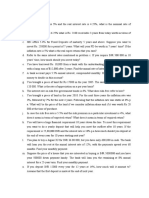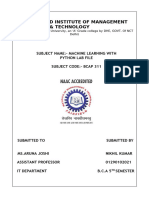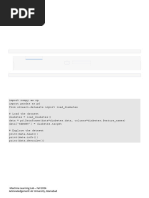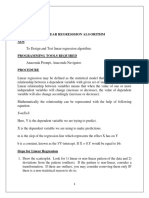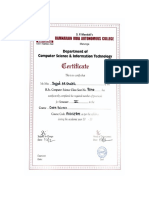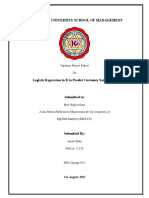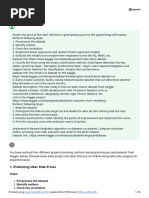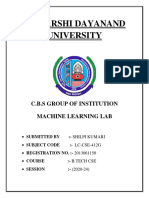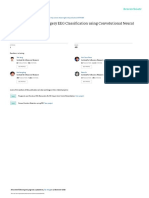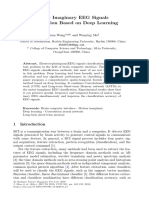Multiple Linear Regression Using Python Machine Learning: Kaleab Woldemariam, June 2017
Uploaded by
apurv shuklaMultiple Linear Regression Using Python Machine Learning: Kaleab Woldemariam, June 2017
Uploaded by
apurv shuklaMultiple Linear Regression using Python Machine Learning
Objective:- The objective of this exercise is to predict the Net
Primary Productivity-(NPP, major ecosystem health indicator) from
climate and land use data for Upper Blue Nile Basin, Ethiopia,
East Africa(Figure 1). It’s derived from Gross Primary
Productivity (GPP) which is an ecosystem level parameter that
refers to the rate at which green plants produce organic matter
by assimilating carbon dioxide using solar energy through
photosynthesis(Liang et al., 2012). Net Primary Productivity is
the difference between GPP and plant autotrophic respiration.
Approximately 50% the organic matter generated by gross primary
production is released into the atmosphere through plant
respiration. The other half, which constitutes NPP is the biomass
produced in a given time (Liang et al., 2012). The following
variables were used:
The NPP dataset(dependent variable) from the year 2001 to 2010
was downloaded from NASA’s Reverb/ECHO website. Data from 2001
was taken for regression analysis.
Precipitation: GPCC-Global Precipitation Climatology Centre,
raster image.
Land use land cover classification image for 2001 and 2010
were acquired from MODIS Land Cover(MCDQ12) from Reverb/ECHO.
Fraction of Photosynthetically Active Radiation (fAPAR) SPOT
satellite, AfSIS raster image(ftp://africagrids.org)
Digital Elevation Model(DEM)- ftp://srtm.csi.cgiar.org.
Minimum Temperature, Vapor Pressure, WSI(Water Stress Index )
derived from Potential Evapotranspiration and Actual
Evapotranspiration of CRU 3.22 Time-Series data (Climate
Research Unit, University of East Anglia)
Kaleab Woldemariam, June 2017
Multiple Linear Regression using Python Machine Learning
Figure 1: Location of the Study Area.
In this exercise, a total of 2,377 random sample points were
collected from the raster data using ArcGIS 10.3. I used Pandas
module for loading comma delimited(csv) file, Numpy module to
convert the data into array, Scikit_Learn for computing multiple
linear regression and Matplotlib module for plotting the result.
Certain assumptions about the dataset must be met before
conducting multiple linear regression. In ecological studies,
statistical and spatial contexts must be considered in modeling.
To simplify, statistical assumptions were met. Multiple linear
regression assumes
(i) Normality
(ii) Homogeneity of Variance
Kaleab Woldemariam, June 2017
Multiple Linear Regression using Python Machine Learning
(iii) Fixed X (X represents explanatory variables)
(iv) Independence
(v) Correct model specification (Zuur et al., 2007).
Note that land use-land cover (LULC) data were categorical and
needed to be converted to dummies (0/1 values).I used a Pandas
function, pd.get_dummies, to manipulate the nominal LULC data to
include it in predicting NPP.
To segregate the numerical and categorical data, I used a
separate pandas DataFrame for Precipitation, fAPAR, Minimum
Temperature, Vapor Pressure, WSI features (numerical independent
variables)as data1 and categorical LULC as dummies and eventually
join the two datasets as a numpy array “X”. The dependent
variable NPP2001 was also converted to array “y” using numpy.
Train/Test
The model is trained to predict the known outputs and later
tested using test data and applied to generalize other non-
trained data. Test data is used to test the prediction ability
(accuracy) of the model. Training data (X_train,y_train) is used
to fit the regression model(make a linear model).This model is
used to predict NPP2001 from independent variables.
'''Regression for predicting NPP using features(independent variables) in Machine
Learning '''
import math
import numpy as np
import pandas as pd
from sklearn import preprocessing,svm
from sklearn.preprocessing import StandardScaler
from sklearn import model_selection,metrics
from sklearn.linear_model import LinearRegression
from sklearn.model_selection import
train_test_split,KFold,cross_val_score,cross_val_predict
Kaleab Woldemariam, June 2017
Multiple Linear Regression using Python Machine Learning
import matplotlib.pyplot as plt
from matplotlib import style
import datetime
style.use('ggplot')
raw_data='mydata_2001_2377_BlueNile.csv'
df = pd.read_csv(raw_data)
# Create a DataFrame for numerical features
data1 = pd.DataFrame(df,
columns=['b1_PG2001','SPTFPR2001','b1_Tmn','X2001WSI','b1_Vap','Elevation'])
print(data1.shape)
# Create a DataFrame for categorical features
cols_to_transform =
pd.DataFrame(df,columns=['Forest','Closed_Shrublands','Open_Shrublands','Woody_Savanna
s','Savannas','Grasslands','Croplands'])
dummies = pd.get_dummies(cols_to_transform)
# Join data1 and dummies using Numpy and yield as array
X = np.array(data1.join(dummies))
# Specify the dependent variable as array
y = np.array(df['NPP2001'])
lm = LinearRegression(n_jobs=-1)
'''To check the accuracy/confidence level of the prediction,
we have 25% test datasets, while 75% is used for training.'''
X_train, X_test, y_train, y_test = train_test_split(X, y, test_size=0.25)
print (X_train.shape, y_train.shape)
print (X_test.shape, y_test.shape)
# First we fit a model
model=lm.fit(X_train,y_train)
#print the coefficents
print("The linear cofficients",model.coef_)
# Try to predict the y ( NPP_Predict) for the test data-features(independent
variables(X_test)
predictions=lm.predict(X_test)
# Accuracy of the prediction
confidence = lm.score(X_test, y_test)
print("This is predicted NPP2001 Values",predictions)
print("This is the prediction accuracy",confidence)
plt.legend(loc=4)
plt.title("Actual NPP2001 vs. NPP2001_Predict", size=10)
plt.scatter(y_test,predictions,color='c', marker='.')
plt.xlabel("Actual NPP2001", size=10)
plt.ylabel("NPP2001_Predict", size=10)
plt.show()
plt.legend(loc=4)
plt.title("Homogeneity of Variance")
plt.scatter(y_test,y_test-predictions)
plt.xlabel("Actual NPP2001")
plt.ylabel("Residual")
plt.show()
#Perform 10 fold Cross Validation (KFold)
scores=cross_val_score(model,X,y,cv=10)
print ("Cross Validated Scores",scores)
kf=KFold(n_splits=10, random_state=None,shuffle=True)
for train_index, test_index in kf.split(X):
Kaleab Woldemariam, June 2017
Multiple Linear Regression using Python Machine Learning
print ("TRAIN", train_index, "TEST", test_index)
X_train,X_test=X[train_index], X[test_index]
y_train,y_test=y[train_index],y[test_index]
# Make Cross Validated predictions
predictions2=cross_val_predict(model,X,y,cv=10)
#Check the R2- the proportion of variance in the dependent variable explained by the
predictors
accuracy=metrics.r2_score(y,predictions2)
print ("This is R2",accuracy)
plt.scatter(y,predictions2,color='c', marker='.')
plt.legend(loc=4)
plt.xlabel("Actual NPP2001", size=10)
plt.ylabel("NPP2001_Predict", size=10)
plt.title("Actual and Predicted NPP2001 Values using 10 Fold Cross
Validation",size=10)
plt.show()
The steps used so far are:-
Load the data.
Convert categorical variables to dummies and join to
numerical variables.
Split the sample (2,377 pts) into training and test sets.
Use training data to fit a regression model.
Made predictions based on the X_test data.
Computed accuracy of the prediction (score).
Train/Test split is not enough to guarantee the randomness of the
samples. If samples fail to be random, this might result in
overfitting. Overfitting means the model is “too well trained”,
although it cannot be applied to other data. Overfitting happens
when the model uses too many predictors; while it works too well
on the training set, it fails on new untrained data. This means
we cannot make inferences from our model.
Cross-Validation method called – K-Folds Cross Validation is used
to subset the sample into k different subsets (or folds). We use
k-1 subsets to train our data and leave the last subset as test
data. We then average the model against each of the folds and
then finalize our model. After that we test it against the test
set. Cross Validated predictions are made by supplying
Kaleab Woldemariam, June 2017
Multiple Linear Regression using Python Machine Learning
cross_val_predict function with the model, X(original/not test
independent variables) and the y(dependent variable),and the
cv(cross validation fold). The plot will have 10x points due to
cross validation.
#Perform 10 fold Cross Validation (KFold)
scores=cross_val_score(model,X,y,cv=10)
print ("Cross Validated Scores",scores)
Cross Validated Scores [ 0.34638801 0.56139146 0.61525375 0.7076254 0.70162425
0.49563864 0.61883974 0.52543957 0.33933734 0.10156286]
# Make Cross Validated predictions
predictions2=cross_val_predict(model,X,y,cv=10)
Finally, the R2-the proportion of variance explained by the
predictors is given by:
accuracy=metrics.r2_score(y,predictions2)
The result indicates that the predictors account for 70.2% of the
variance in the Net Primary Productivity for year 2001.
The linear equation:
1.274E-04*(b1_PG2001)+2.314E-03*(SPTFPR2001)-1.147E-01*(b1_Tmn)+8.877E-
1*(X2001WSI)+1.326E-01*(b1_Vap)-3.43E-05*(Elevation)-1.0E-01*(Forest)-
1.27*(Closed_Shrublands)-9.79*(Open_Shrublands)-1.019E-01*(Woody_Savannas)-
9.549E-02*(Savannas)-1.0422*(Grasslands)-1.22E-02*Croplands
Kaleab Woldemariam, June 2017
Multiple Linear Regression using Python Machine Learning
Kaleab Woldemariam, June 2017
Multiple Linear Regression using Python Machine Learning
Reference
https://www.medium.com/towards-data-science/train-test-split-and-
cross-validation-in-python-80b61beca4b6 retrieved on June 28,
2017.
Liang, S.,Li,X., Wang, J., 2012. Advanced Remote Sensing:
Terrestrial Information Extraction and Applications, Academic
Press, pp. 800.
Zuur, A. K., Ieno, E.N., Smith, G. M., 2007. Statistics for
Biology and Health: Analyzing Ecological Data, Springer Science +
Business Media, LLC.
Kaleab Woldemariam, June 2017
You might also like
- Assignment 1:: Intro To Machine LearningNo ratings yetAssignment 1:: Intro To Machine Learning6 pages
- The Implication of Statistical Analysis and Feature Engineering For Model Building Using Machine Learning AlgorithmsNo ratings yetThe Implication of Statistical Analysis and Feature Engineering For Model Building Using Machine Learning Algorithms11 pages
- ML0101EN Reg Mulitple Linear Regression Co2 Py v1No ratings yetML0101EN Reg Mulitple Linear Regression Co2 Py v15 pages
- ML-Lab07-Building and Evaluating Multivariate Regression Models in PythonNo ratings yetML-Lab07-Building and Evaluating Multivariate Regression Models in Python5 pages
- SYNTHETIC CLIMATE DATA GENERATION FOR IMPROVING AI^J PROJECT GROUP 5No ratings yetSYNTHETIC CLIMATE DATA GENERATION FOR IMPROVING AI^J PROJECT GROUP 56 pages
- ML0101EN Reg Simple Linear Regression Co2 Py v1No ratings yetML0101EN Reg Simple Linear Regression Co2 Py v14 pages
- Time Series Forecast of Electrical Load Based On XGBoostNo ratings yetTime Series Forecast of Electrical Load Based On XGBoost10 pages
- Predicting Forest Fires With Machine LearningNo ratings yetPredicting Forest Fires With Machine Learning4 pages
- 20240514_Kazadi_Joel_9213934_DLMDSPWP01No ratings yet20240514_Kazadi_Joel_9213934_DLMDSPWP0118 pages
- New Chat: 1. Predicting Uber Ride PricesNo ratings yetNew Chat: 1. Predicting Uber Ride Prices16 pages
- Rainfall Prediction using Machine LearningNo ratings yetRainfall Prediction using Machine Learning9 pages
- Activity 01: Python Set/s of Source Code Use in The Activity (Paste Below)No ratings yetActivity 01: Python Set/s of Source Code Use in The Activity (Paste Below)2 pages
- DATA MINING AND MACHINE LEARNING. PREDICTIVE TECHNIQUES: REGRESSION, GENERALIZED LINEAR MODELS, SUPPORT VECTOR MACHINE AND NEURAL NETWORKSFrom EverandDATA MINING AND MACHINE LEARNING. PREDICTIVE TECHNIQUES: REGRESSION, GENERALIZED LINEAR MODELS, SUPPORT VECTOR MACHINE AND NEURAL NETWORKSNo ratings yet
- Image-Based Motor Imagery EEG Classification Using Convolutional Neural NetworkNo ratings yetImage-Based Motor Imagery EEG Classification Using Convolutional Neural Network5 pages
- Drones: Drone-Action: An Outdoor Recorded Drone Video Dataset For Action RecognitionNo ratings yetDrones: Drone-Action: An Outdoor Recorded Drone Video Dataset For Action Recognition16 pages
- Chapter 3_P1_MSI Logic Circuit (Decoder-Encoder)No ratings yetChapter 3_P1_MSI Logic Circuit (Decoder-Encoder)67 pages
- A New Method of Balancing Supercapacitors in A Series Stack Using MosfetsNo ratings yetA New Method of Balancing Supercapacitors in A Series Stack Using Mosfets7 pages
- Smart TV Mainboard ZLS47HIS-V1 With Cannot Startup Problem SolvedNo ratings yetSmart TV Mainboard ZLS47HIS-V1 With Cannot Startup Problem Solved6 pages
- Three-And Four-Point Method: Resistance MeasurementsNo ratings yetThree-And Four-Point Method: Resistance Measurements8 pages
- Csir-Net June 2011 (Question Paper) Part ANo ratings yetCsir-Net June 2011 (Question Paper) Part A3 pages
- Solcon USA HRVS DN MV 10 13pt8kV Spec Guide 2011100% (1)Solcon USA HRVS DN MV 10 13pt8kV Spec Guide 201110 pages
- Solved Past Paper BS AD Semester 8 (Thermoanalysis Method) Chem-468No ratings yetSolved Past Paper BS AD Semester 8 (Thermoanalysis Method) Chem-46811 pages
- New No. 3, Old No. 2, S.V. Koil Street, Sekar Nagar, Ashok Nagar, Chennai - 60083 Phone: +91 (044 43518677 - Cell: (+91) 9789976777, 9940077338 EmailNo ratings yetNew No. 3, Old No. 2, S.V. Koil Street, Sekar Nagar, Ashok Nagar, Chennai - 60083 Phone: +91 (044 43518677 - Cell: (+91) 9789976777, 9940077338 Email4 pages
- Thermal Dehydrocondensation of Benzene To Diphenyl in A Nonisothermal Flow ReactorNo ratings yetThermal Dehydrocondensation of Benzene To Diphenyl in A Nonisothermal Flow Reactor6 pages
- Problems Theory and Solutions in Linear AlgebraNo ratings yetProblems Theory and Solutions in Linear Algebra169 pages
- Security Management in Wireless Sensor Network (WSN)No ratings yetSecurity Management in Wireless Sensor Network (WSN)4 pages
- The Implication of Statistical Analysis and Feature Engineering For Model Building Using Machine Learning AlgorithmsThe Implication of Statistical Analysis and Feature Engineering For Model Building Using Machine Learning Algorithms
- ML-Lab07-Building and Evaluating Multivariate Regression Models in PythonML-Lab07-Building and Evaluating Multivariate Regression Models in Python
- SYNTHETIC CLIMATE DATA GENERATION FOR IMPROVING AI^J PROJECT GROUP 5SYNTHETIC CLIMATE DATA GENERATION FOR IMPROVING AI^J PROJECT GROUP 5
- Time Series Forecast of Electrical Load Based On XGBoostTime Series Forecast of Electrical Load Based On XGBoost
- Activity 01: Python Set/s of Source Code Use in The Activity (Paste Below)Activity 01: Python Set/s of Source Code Use in The Activity (Paste Below)
- DATA MINING AND MACHINE LEARNING. PREDICTIVE TECHNIQUES: REGRESSION, GENERALIZED LINEAR MODELS, SUPPORT VECTOR MACHINE AND NEURAL NETWORKSFrom EverandDATA MINING AND MACHINE LEARNING. PREDICTIVE TECHNIQUES: REGRESSION, GENERALIZED LINEAR MODELS, SUPPORT VECTOR MACHINE AND NEURAL NETWORKS
- Image-Based Motor Imagery EEG Classification Using Convolutional Neural NetworkImage-Based Motor Imagery EEG Classification Using Convolutional Neural Network
- Drones: Drone-Action: An Outdoor Recorded Drone Video Dataset For Action RecognitionDrones: Drone-Action: An Outdoor Recorded Drone Video Dataset For Action Recognition
- A New Method of Balancing Supercapacitors in A Series Stack Using MosfetsA New Method of Balancing Supercapacitors in A Series Stack Using Mosfets
- Smart TV Mainboard ZLS47HIS-V1 With Cannot Startup Problem SolvedSmart TV Mainboard ZLS47HIS-V1 With Cannot Startup Problem Solved
- Three-And Four-Point Method: Resistance MeasurementsThree-And Four-Point Method: Resistance Measurements
- Solved Past Paper BS AD Semester 8 (Thermoanalysis Method) Chem-468Solved Past Paper BS AD Semester 8 (Thermoanalysis Method) Chem-468
- New No. 3, Old No. 2, S.V. Koil Street, Sekar Nagar, Ashok Nagar, Chennai - 60083 Phone: +91 (044 43518677 - Cell: (+91) 9789976777, 9940077338 EmailNew No. 3, Old No. 2, S.V. Koil Street, Sekar Nagar, Ashok Nagar, Chennai - 60083 Phone: +91 (044 43518677 - Cell: (+91) 9789976777, 9940077338 Email
- Thermal Dehydrocondensation of Benzene To Diphenyl in A Nonisothermal Flow ReactorThermal Dehydrocondensation of Benzene To Diphenyl in A Nonisothermal Flow Reactor
- Security Management in Wireless Sensor Network (WSN)Security Management in Wireless Sensor Network (WSN)


